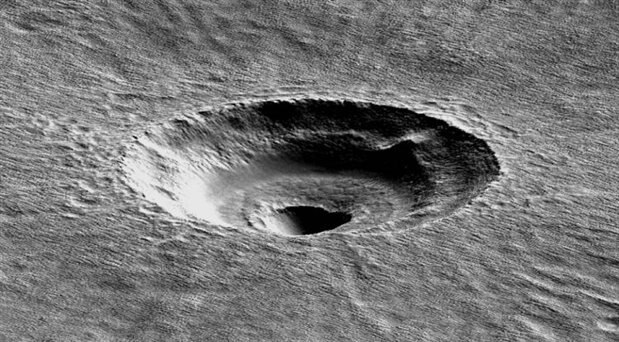Combining data obtained from two powerful instruments aboard NASA's Mars Reconnaissance Orbiter (MRO), researchers at the University of Arizona's Lunar and Planetary Laboratory (LPL) determined why the crater shown above is terraced — not bowl shaped, like most craters of this size.
Terraces can form when there are layers of different materials in the planet’s subsurface, such as dirt, ice or rock. When the crater is forming, the shock wave from an object hitting a planet’s surface propagates differently depending on what substrates are beneath the area of impact. If there is a weaker material in one layer, the shock wave can push out that material more easily, and the result is terracing at the interface between the weaker and stronger materials.
Using MRO’s High Resolution Imaging Science Experiment (HiRISE) camera, which is operated out of LPL, the researchers created three-dimensional models of the area's craters, which allowed them to measure the depth of their terraces. The researchers then used MRO’s Shallow Radar (SHARAD), instrument to beam radar pulses to Mars, allowing them to measure the time it took for the radar signals to penetrate the surface’s buried layers and bounce back. Combining the two data sets to measure the radar waves’ speed was a pivotal clue to the layers’ composition.
In this crater’s case, the layers turned out to be ice, and lots of it. Just beneath Mars’ dirt surface, or regolith, the researchers found an enormous slab of water ice, measuring 130 feet thick and covering an area equivalent to that of California and Texas combined.
Although scientists have known for some time about Mars’ icy deposits at its poles and have used them to look at its climatic history, knowledge of icy layers at the planet’s mid-latitudes, analogous to latitudes falling between the Canadian-U.S. border and Kansas on Earth, is something new. And Arcadia Planitia, the area of Mars under study, has a lot of terraced craters,
One possible explanation for the huge amount of water ice is that like the Earth, Mars has had a number of severe climate changes, including several ice ages, in its past. These frequent climate changes are believed to be due to its obliquity — the degree the planet tilts on its axis. Unlike Earth, Mars doesn’t have a large moon to keep it stable. Instead, it wobbles on its axis, and that wobbling leads to the dramatic climatic shifts,,which in turn have led to intermittent ice ages.
The researchers' results have been published online in “Geophysical Research Letters”, a journal of the American Geophysical Union.

